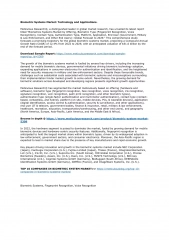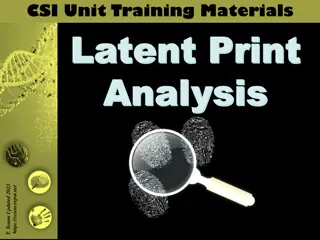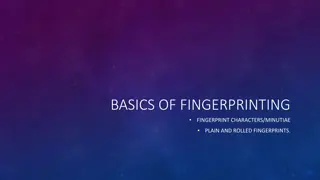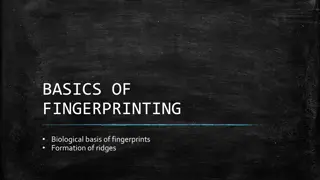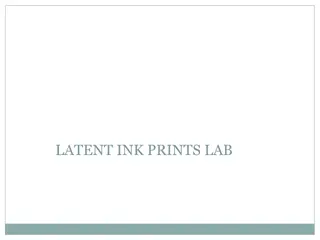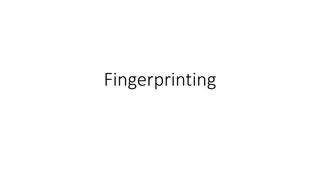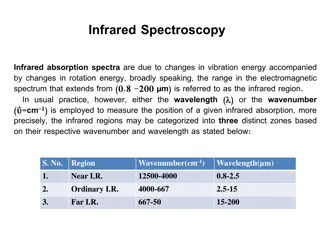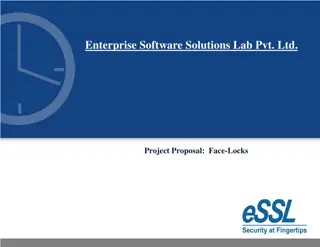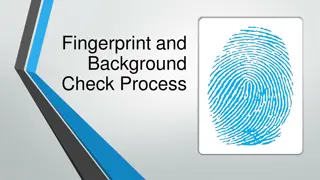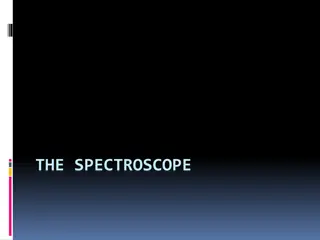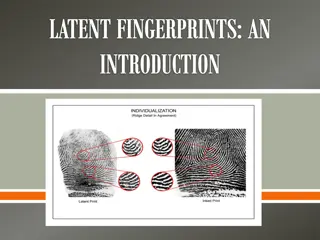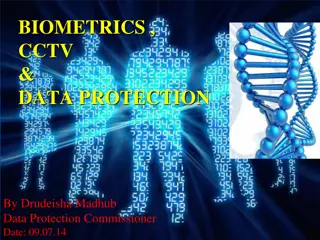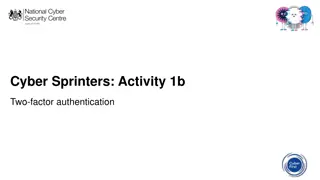Understanding Fingerprint Development Techniques
Exploring the development of latent fingerprints through physical and chemical methods, conditions affecting latent prints, and various fingerprint development techniques like visual examination, powder techniques, and chemical techniques. Techniques such as alternate light sources and powder methods contribute to effective fingerprint visualization and analysis.
Download Presentation

Please find below an Image/Link to download the presentation.
The content on the website is provided AS IS for your information and personal use only. It may not be sold, licensed, or shared on other websites without obtaining consent from the author. Download presentation by click this link. If you encounter any issues during the download, it is possible that the publisher has removed the file from their server.
E N D
Presentation Transcript
DEVELOPMENT OF FINGERPRINTS Latent Prints Latent Fingerprints detection by physical and chemical techniques
LATENT PRINTS Latent means hidden. Caused when friction ridges of the skin is pressed against another surface (due to the presence of sweat). Also known as chance prints. Can be visualized by using oblique lighting, Development through either physical or chemical method is required in order to make the print usable or readable.
CONDITIONS AFFECTING LATENT PRINTS Type of surface: best surface is smooth, clean, and glossy or nonporous. Manner in which the object was touched: If the finger moves slightly while in contact with the object, ridge detail may be lost or distorted. Weather: May dry out or wash away the print Humidity: May cause print to be absorbed into a surface or to dissipate. Perspiration: May obliterate print if both ridges and valleys are covered and constituent of perspiration may affect the print. Use of the object Care of the suspect
FINGERPRINT DEVELOPMENT TECHNIQUES Visual examination Powder Techniques Chemical Techniques
VISUAL EXAMINATION Inherent lighting can be used followed by illumination with oblique lighting. Infrared, or ultraviolet lighting may be utilized. Moisture from the breath can also assist in detection of the prints
ALTERNATE LIGHT SOURCE (ALS) Devices providing monochromatic light at specific wavelengths are known as Alternate Light Source (ALS). It utilizes the inherent luminescent properties of materials (biological fluids, fibers, latent prints) to locate them.
POWDER TECHNIQUES Black Powder White Powder Fluorescent Powder Bichromatic Powder Fluorescent Powders : additional luminescence is required in the form of an alternate light source (ALS) or laser. Magnetic Powder Not for prints on metal surfaces cause it may cause scratches on a surface and degrade or contaminate latent prints. The reason for the variety of powders is to provide the greatest contrast with the background on which the fingerprint is developed.
CHEMICAL TECHNIQUES Reagents react with substances contained in the sweat and with fingerprint impression. Chloride), protein, amino acids, lipids, and oil react with the sweat and it s constituents to reveal the latent prints. Other substances might include blood, grease, or food stuffs.
1. CYANOACRYLATE ESTER Reacts with the amino acids and fatty acids in the perspiration and form a white coloured polymer. Contrast may be enhanced by using powders or dye stains on the developed polymer. An ALS or laser (in case of fluorescent powder) is used to enhance the print Method may be applied to metal, glass, plastic, garbage bags, electrical tape, and many other nonporous surfaces. Can be used by fuming chamber or tenting method, or with a wand.
a) Fresh Fingerprint on stainless steel b) Old Fingerprint on stainless steel c) Fresh Fingerprint on Aluminum Surface d) Old Fingerprint on Aluminum Surface
2. IODINE FUMING Iodine reacts with fatty acids and lipids contained in the fingerprint and gives a dark brownish to blackish appearance Can be used for paper and on human skin (porous surfaces) The two most common : Iodine fuming gun Fuming cabinet. Iodine dusting Iodine solution. Technique corrosive and may pose safety issues when improperly applied. The developed prints must be photographed as the prints tend to fade over time.
Developed print fades over time Lab set up for Iodine fuming
NINHYDRIN Ninhydrin reacts with the amino acids, peptides, and protein present in the print and produces Ruhemann s purple ( pinkish-purple color). One can use commercially available Ninhydrin solution or make a fresh one too. Solution can be made by mixing 25 grams of Ninhydrin crystals into 4 liters of solvent. Solution that can be applied by using Spray. Swabbing method. Dipping method. Can be used on items such as paper, cardboard, and unfinished wood (porous surfaces). Temperature should be approximately 80 F (26.6 Celsius), with a humidity rate of approximately 80 percent. Effective for old prints too.
DFO (1,8,-DIAZAFLUOREN-9-ONE) It reacts with amino acids, peptides, and protein contained in the print and results in faint red or pink fingerprints which are intensely fluorescent at room temperature. Ninhydrin analogue and is 2.5 times more sensitive than Ninhydrin. Can be used on porous surfaces. Methods - Dipping or swabbing. DFO reaction requires a Unlike Ninhydrin, high-temperature, low-humidity environment are required for good development. After DFO application and heating, developed fingerprints can be observed using 530 nm excitation light and a 590 nm barrier. ALS or laser are used for better visualization.
STICKY SIDE POWDER/GENTIAN VIOLET React with amino acids. Used on sticky surfaces such as adhesive tapes (masking, duct, packaging). Gentian violet : Dipping method. Sticky Side Powder : dipping method or by painting the adhesive surface. Shiny side of tape should be processed for fingerprints before applying either technique. Appropriate safety gear is a must when using either of these techniques.
CHEMICALS THAT REACT WITH BLOOD Leuco-malachite Green: spraying on the suspected area, yields green colored prints. Leuco-Crystal Violet: When sprayed on the suspected area, the prints will turn purplish- black. Amido Black/Sudan Black: When sprayed on the suspected area, the prints will turn dark bluish-black. Luminol: When sprayed on the suspected area, the prints will fluoresce. Must be used in darkened room. Prints must be photographed at the time of fluorescence because when luminol stops reacting with the blood, the prints will no longer be visible.
SEQUENTIAL PROCESSING Available light (ambient light/flashlight/ALS/ultraviolet) Powder techniques DFO Ninhydrin Dye stain


